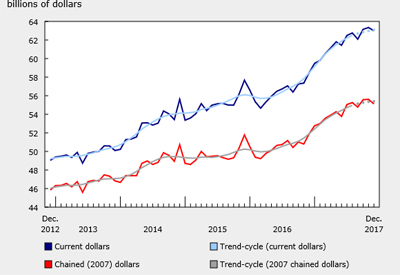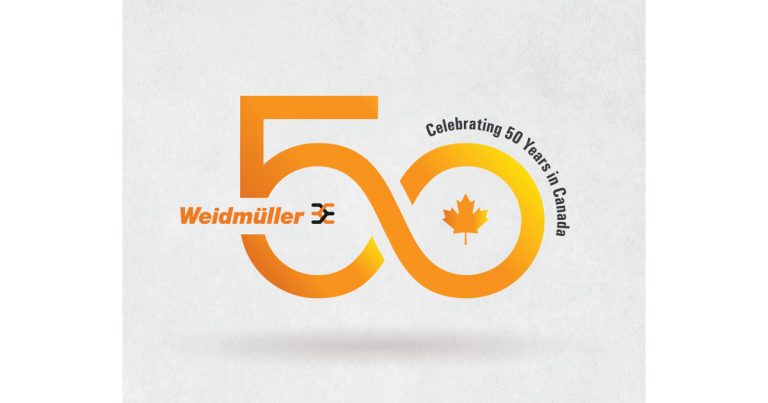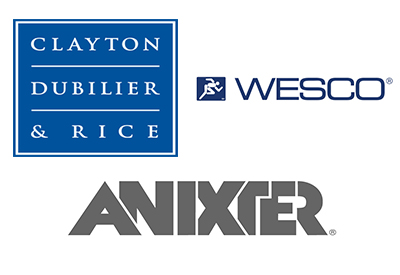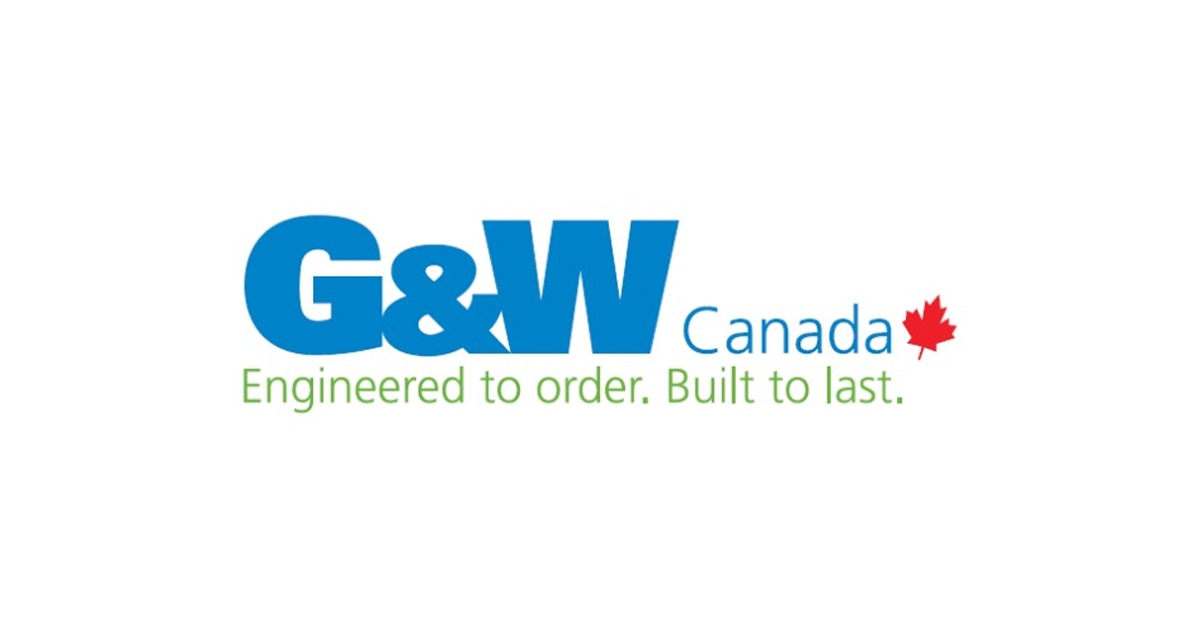Wholesale Sales Declined 0.5% in December

February 22, 2018
Wholesale sales declined 0.5% to $63.0 billion in December, the first decrease in three months. Lower sales were recorded in five of seven subsectors, representing 65% of total wholesale sales. The personal and household goods and the miscellaneous subsectors led the decline.
In volume terms, wholesale sales declined 0.9%.
In the fourth quarter, current dollar wholesale sales increased 1.1% while constant dollar sales increased 0.7%. For both current and constant dollars, this marked the seventh consecutive quarterly increase.
December decline attributable to decreases in five of seven subsectors
The personal and household goods subsector reported the largest decline in dollar terms in December, dropping 3.3% to $8.5 billion, its lowest level since April 2017 and only the third decrease for the subsector in 2017. Five of six industries in this subsector reported declines in December, led by the home entertainment equipment and household appliance industry.
Sales in the miscellaneous subsector fell 2.4% to $7.9 billion, erasing the combined gains from the previous two months. Four of five industries posted declines, with the decrease in the agricultural supplies industry being the leading contributor to December’s downward movement.
Wholesale sales declined 1.4% in both the food, beverage and tobacco, and the motor vehicle and parts subsectors in December. Sales in the food, beverage and tobacco subsector fell to $12.0 billion as a result of drops posted in the food industry, down 1.9% to $10.8 billion. In the motor vehicle and parts subsector, all three industries posted declines in December, with the motor vehicle industry being the leading contributor.
Sales in both the machinery, equipment and supplies (+2.3% to $12.7 billion) and the building material and supplies (+2.7% to $9.3 billion) subsectors recorded gains in December.
Six provinces record declines in December, led by Ontario
Ontario recorded a second decline in 2017, down 0.8% to $32.6 billion in December. Three of seven subsectors declined, led by the personal and household goods subsector (-7.3%). This subsector has declined for three of the past four months. The food, beverage and tobacco subsector (-2.0%) declined to $5.2 billion, the fourth decrease in five months. Despite the decline, the subsector remains up 0.1% over the last five months. The building material and supplies subsector (-2.7%) declined for the second time in three months, to $3.6 billion.
Quebec recorded a third decline in four months, down 1.3% to $11.3 billion. In December, five subsectors recorded declines, led by the miscellaneous (-10.4%) and the machinery, equipment and supplies (-5.0%) subsectors.
New Brunswick declined for the first time in four months, down 6.1% to $554 million in December. Four of seven subsectors decreased, with the largest drop coming from the food, beverage and tobacco subsector (-12.9%).
Alberta (+0.9%) and British Columbia (+0.5%) were two of four provinces that recorded increases in December, both on the strength of the building material and supplies subsector. This was Alberta’s third increase in four months, while British Columbia recorded a second increase in three months.
Wholesale inventories rise in December
Wholesale inventories rose 1.7% to $82.8 billion in December. Four of seven subsectors posted increases, representing 66% of total wholesale inventories.
In dollar terms, the machinery, equipment and supplies subsector (+3.6%) led the increase, with higher inventories in three of four industries. The construction, forestry and mining (+5.1%) and the farm, lawn and garden (+6.2%) industries contributed the most to the gain.
Inventories in the food, beverage and tobacco subsector (+5.6%) grew for the tenth consecutive month. Elevated inventory levels in the subsector were largely attributable to a 4.9% gain in the food industry.
The motor vehicle and parts subsector (+2.3%) rose for the first time in three months. The majority of the increase was driven by the new motor vehicle parts and accessories (+3.2%) and the motor vehicle (+1.7%) industries.
The inventory-to-sales ratio increased from 1.29 in November to 1.31 in December. This ratio is a measure of the time in months required to exhaust inventories if sales were to remain at their current level.
The year 2017 in review
Wholesale trade in Canada rose for the eighth consecutive year in 2017, up 9.4% to $741.1 billion, as a result of higher sales in all seven subsectors. This was the highest growth rate since 1997 (+13.7%) and the highest level on record. Growth in wholesale trade in 2017 was driven mainly by growth in the first two quarters, up 3.9% and 2.5% respectively.
In volume terms, wholesale sales were up 7.7% to $652.7 billion in 2017, reaching their highest level and growth rate on record.
In 2017, the machinery, equipment and supplies subsector was the largest contributor to higher wholesale sales, followed by the motor vehicle and parts subsector and the building material and supplies subsector.
Higher sales were recorded in all provinces, led by Ontario and Quebec.
According to the Survey of Employment, Payrolls and Hours, an average of 777,275 payroll employees worked in wholesale trade from January 2017 to November 2017, up 0.4% after declining 1.2% for the same period in 2016. For the same time period, the wholesale trade sector accounted for 5.9% of Canada’s economic output as measured by gross domestic product.
Labour productivity, or output per hour worked, in the wholesale trade sector grew 3.9% in the first quarter of 2017, as output increased 3.8% and hours worked edged down 0.2%. This was the second consecutive quarterly increase and the highest growth rate since the fourth quarter of 2005 (+5.1%). The wholesale trade sector, along with the finance and insurance, retail trade, and manufacturing sectors, were the main sources of overall productivity growth among industry sectors in the first quarter.
Higher sales in the machinery, equipment and supplies subsector coincides with gains in business investment
The machinery, equipment and supplies subsector, the largest of the seven subsectors, accounted for 19.7% of wholesale sales in 2017. After two consecutive annual declines, wholesale sales in this subsector grew by 10.8% to $146.0 billion. On a quarterly basis, the machinery equipment and supplies subsector was one of the leading contributors to the gains in the first (+4.7%) and second (+5.4%) quarters. These gains coincided with those reported in the business investment in machinery and equipment as measured by expenditure-based real gross domestic product, up 6.4% in the first quarter and 1.7% in the second quarter.
Higher sales in the machinery, equipment and supplies subsector were due to gains reported in all industries within the subsector, led by the construction, forestry, mining, and industrial machinery, equipment and supplies industry. This industry grew 13.6% to $46.9 billion in 2017, more than offsetting two consecutive annual declines. The gains in this industry coincided with those reported by the imports (+37.0%) and exports (+2.5%) of logging, mining and construction machinery equipment in 2017.
The other machinery equipment and supplies industry increased for the third consecutive year, up 16.5% to $35.3 billion in 2017.
Growth in the motor vehicle and parts subsector
The motor vehicle and parts subsector reached its highest level on record, rising 10.1% to $140.2 billion in 2017. Imports of motor vehicles and parts (+4.9%) also reported gains in 2017.
In 2017, higher sales were reported in all industries. The gain was mainly attributable to the motor vehicle industry, which increased for the eighth consecutive year, up 10.6% to $113.0 billion. The new motor vehicle parts and accessories (+7.8%) and the used motor vehicle parts and accessories (+19.9%) industries also increased in 2017, following declines in 2016.
Higher prices of lumber and metal boost sales in the building material and supplies subsector
Sales in the building material and supplies subsector increased 11.8% to $104.5 billion in 2017, its highest growth rate since 2004. A gain in the lumber, millwork, hardware and other building supplies industry contributed the most to the increase, as the industry grew 12.0% to $52.6 billion. Related indicators including housing starts (+12.0%), and exports (+3.9%) and imports (+3.8%) of building and packaging materials, also increased in 2017. The industrial product price index for lumber and other wood products increased 4.9%, its highest growth rate since 2004.
The metal service centres industry increased following two consecutive annual declines, up 16.6% to $19.9 billion in 2017. The growth was attributable to increases in metal prices and capital spending in oil and gas exploration. The raw material price index for metal ores, concentrates and scrap increased 12.2%, while capital spending on oil and gas and mineral exploration was up 2.5%.
Ontario and Quebec contribute to higher sales
Wholesale sales increased in all provinces in 2017, led by Ontario and Quebec. Ontario accounted for 51.5% of total wholesale sales.
Sales in Ontario increased 9.3% to $381.3 billion on the strength of widespread gains, led by the miscellaneous (+20.3%) and the motor vehicle and parts (+8.0%) subsectors.
In Quebec, wholesale sales increased 10.0% to $133.4 billion led by the motor vehicle and parts (+24.0%) and the food, beverage and tobacco (+10.7%) subsectors.
The machinery, equipment and supplies subsector led the gains in the Prairie region, with Alberta contributing the most to the gains. Sales in Alberta increased following two consecutive annual declines, up 10.5% to $79.3 billion. The gain in Alberta coincided with the increasing business investment and stability in oil prices as the province recovered from two years of economic contraction. Capital spending in Alberta’s oil and gas and mineral exploration grew by 15.7%, following a 58.6% decline in 2016. Higher sales in Saskatchewan (+7.1%) and Manitoba (+7.4%) were also led by the machinery, equipment and supplies subsector.
Wholesale sales in British Columbia increased for the eighth consecutive year, up 9.7% to $76.6 billion. The strongest growth came in the building material and supplies subsector, as the housing market posted gains along with a rise in prices of lumber and other wood products.
Source: Statistics Canada, https://www.statcan.gc.ca/daily-quotidien/180220/dq180220a-eng.htm











